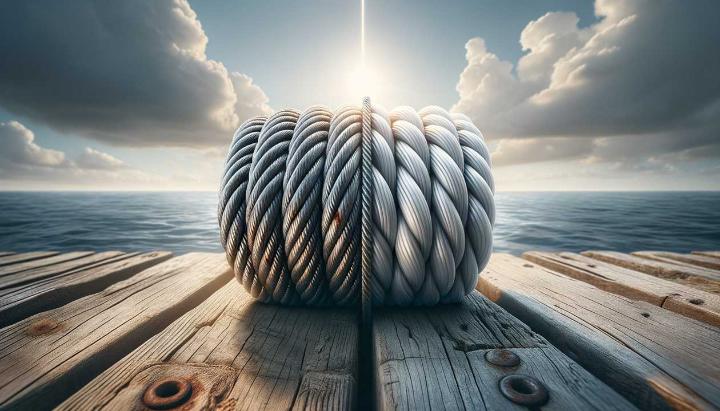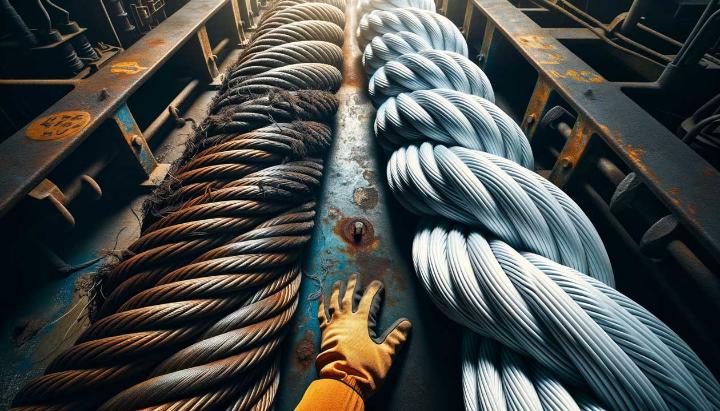Have you ever wondered why a seemingly simple choice between braided steel cable and synthetic UHMWPE rope could make or break your next project? In the high-stakes world of industrial rigging, marine operations, and off-road adventures, this decision is far from trivial. It's a choice that could mean the difference between success and failure, safety and danger.
For decades, braided steel cable has been the go-to option for heavy-duty applications, prized for its strength and durability. But there's a new player in town - synthetic UHMWPE rope - and it's challenging everything we thought we knew about lifting and pulling solutions.
In this eye-opening comparison, we'll delve into the strengths and weaknesses of both materials, exploring how they stack up in terms of safety, weight, and strength. You'll discover why iRopes' cutting-edge UHMWPE rope is revolutionising industries across the board, from construction to maritime, and why it might just be the game-changer your operation needs.
Prepare to have your preconceptions challenged as we unravel the truth behind these two titans of tension. Whether you're a seasoned professional or new to the world of high-performance ropes, this guide will equip you with the knowledge to make informed decisions that could transform your efficiency, safety, and bottom line. Are you ready to rope in the future of industrial rigging?
Key Advantages of Braided Steel Cable
When it comes to heavy-duty applications, braided steel cable has long been the go-to choice for many industries. As someone who's worked with various cable types over the years, I can attest to the impressive capabilities of this versatile material. Let's dive into the key advantages that make braided steel cable a top contender in the world of industrial rigging and beyond.
Durability and Longevity of Braided Steel Cables
Have you ever wondered why some structures and machinery seem to withstand the test of time? The secret often lies in the materials used, and braided steel cable is a prime example of durability in action.
- Superior strength and flexibility: The unique braided construction allows for incredible tensile strength while maintaining flexibility, a combination that's hard to beat in demanding environments.
- Resistance to wear and tear: I've seen braided cables outlast their solid counterparts in applications where constant movement would quickly degrade other materials.
- Corrosion resistance: Particularly in marine environments, the ability to resist corrosion is crucial. Braided steel cables often feature protective coatings that significantly extend their lifespan in harsh conditions.

Applications and Uses for Braided Steel Cable
The versatility of braided steel cable never ceases to amaze me. From towering construction cranes to the intricate rigging of sailing vessels, these cables play a crucial role in countless industries.
- Construction and heavy lifting: The 1/2 steel winch cable is a prime example of braided steel's capability to handle immense loads safely and reliably.
- Marine applications: From mooring lines to support cables for offshore platforms, the corrosion resistance and strength of braided steel are invaluable.
- Telecommunications: Believe it or not, braided steel cables provide excellent EMI shielding, protecting sensitive data transmissions in various communication systems.
One particularly memorable project I worked on involved retrofitting an old industrial crane with new braided steel cables. The difference in performance and reliability was night and day – the smooth operation and increased load capacity were immediately noticeable.
Did you know? Braided steel cables can offer up to 15% more strength than their non-braided counterparts of the same diameter, making them ideal for applications where space is at a premium but strength is paramount.
While braided steel cable boasts impressive strength and durability, it's important to consider all options when choosing the right material for your specific needs. As we explore further, we'll compare these advantages with those of synthetic alternatives like UHMWPE rope to give you a comprehensive understanding of your choices.
Benefits of Synthetic UHMWPE Rope
As someone who's spent years working with various types of ropes and cables, I've seen firsthand how synthetic UHMWPE rope has revolutionised many industries. Let's dive into why this innovative material is making waves and outperforming traditional braided steel wire in numerous applications.
Advantages Over Steel Cable
The moment you pick up a synthetic UHMWPE rope, you'll notice its most striking feature - it's incredibly light. In fact, it's up to 80% lighter than steel wire rope of the same diameter. This weight difference isn't just about convenience; it's a game-changer for many operations.
- Effortless handling: The lightweight nature of UHMWPE rope means less physical strain on workers during installation and use. I've seen teams complete rigging tasks in half the time it would take with steel cable.
- Improved safety: Unlike steel cable, synthetic rope doesn't develop those nasty sharp burrs that can injure handlers. Plus, its lower weight means reduced risk of back injuries during manual handling.
- Exceptional strength: Don't let its light weight fool you. UHMWPE rope boasts a strength-to-weight ratio that often surpasses steel cable, allowing for higher load capacities in many applications.

Applications in Various Industries
The versatility of synthetic UHMWPE rope has seen it adopted across a wide range of sectors. Here are just a few examples of how it's making a difference:
- Vehicle recovery: In off-road scenarios, UHMWPE rope's ability to float makes water crossings much safer. I once witnessed a 4x4 easily recovered from a deep creek using a synthetic winch line - a task that would have been far more dangerous with a heavy steel cable.
- Mining operations: The reduced weight of UHMWPE rope means easier installation in deep shaft systems, improving both efficiency and worker safety. A mining engineer I know swears by it for its durability in harsh underground conditions.
- Logging industry: Forestry workers appreciate how UHMWPE rope reduces equipment wear and tear. Its lower weight means less stress on winches and other machinery, leading to longer service life and reduced maintenance costs.
Have you considered how switching to synthetic UHMWPE rope could benefit your operations? Whether you're in construction, marine work, or any industry requiring robust lifting and pulling solutions, the advantages are clear. It's not just about replacing steel cable - it's about upgrading to a safer, more efficient future.
Did you know? UHMWPE rope has a much lower environmental impact than steel cable production. It requires less energy to manufacture and transport, making it a more sustainable choice for eco-conscious businesses.
As we continue to explore the world of high-performance ropes and cables, it's clear that synthetic UHMWPE rope is leading the charge in innovation and efficiency. Its combination of strength, safety, and versatility makes it a superior choice for many applications where traditional steel cable once reigned supreme.
Comparing Safety, Weight, and Strength in Engineering
When it comes to choosing between braided steel cable and synthetic UHMWPE rope, understanding the interplay of safety, weight, and strength is crucial. As an engineer who's worked on numerous projects involving both materials, I've seen firsthand how these factors can make or break an operation.
Understanding Breaking Strength vs Working Load Limit
Let's start with two key concepts: breaking strength and working load limit (WLL). Breaking strength is the maximum force a rope or cable can withstand before failing, while the WLL is the safe load that can be applied during normal use. It's like the difference between pushing your car to its absolute limit and driving it comfortably on a daily basis.
- Breaking strength: For a 1/2" steel winch cable, this might be around 26,600 lbs.
- Working load limit: The WLL for the same cable would typically be about 5,320 lbs, following a 5:1 safety factor.
Now, here's where UHMWPE rope shines. A 1/2" UHMWPE rope can have a breaking strength of up to 70,000 lbs, with a proportionally higher WLL. This means you can achieve the same or better performance with a much lighter rope.
Factor of Safety: Balancing Risk and Performance
The factor of safety is the ratio between breaking strength and WLL. It's our safety net, ensuring we're not pushing equipment to its limits. Different industries use varying safety factors based on their specific risks and requirements.
Did you know? The standard safety factor for lifting devices is often 5:1 or 6:1, but in some high-risk applications, it can be as high as 10:1.
UHMWPE rope's superior strength-to-weight ratio allows for higher safety factors without compromising on performance. This is particularly valuable in industries where every gram counts, such as aerospace or high-altitude operations.
Weight Considerations: The UHMWPE Advantage
Weight is where UHMWPE rope truly outshines braided steel cable. I once worked on a project replacing steel cables with UHMWPE ropes on a series of cranes. The weight reduction was staggering - nearly 80%! This led to:
- Improved fuel efficiency: The lighter equipment required less energy to operate.
- Enhanced safety: Reduced risk of back injuries and easier handling for workers.
- Increased productivity: Quicker setup and teardown times due to easier manipulation of the lighter ropes.
The weight savings of UHMWPE rope don't just make life easier for workers; they can fundamentally change how we approach engineering challenges. Imagine being able to lift heavier loads with the same equipment, or reaching greater heights without worrying about the cable's own weight becoming a limiting factor.

In conclusion, while braided steel cable has served us well for decades, synthetic UHMWPE rope is revolutionising the field. Its unparalleled strength-to-weight ratio, coupled with enhanced safety features, makes it the superior choice for many modern engineering challenges. As we continue to push the boundaries of what's possible in construction, marine operations, and beyond, UHMWPE rope is proving to be an invaluable tool in our engineering toolkit.
iRopes' Synthetic UHMWPE Rope: Superior Strength and Performance
As we've explored the advantages of both braided steel cable and synthetic UHMWPE rope, it's clear that each has its strengths. However, when it comes to cutting-edge performance and versatility, iRopes' synthetic UHMWPE rope stands out as a game-changer in the industry. Let me share with you why this remarkable material has become the go-to choice for professionals across various sectors.
Advantages of UHMWPE Rope for Various Applications
Having worked with numerous rope materials throughout my career, I can confidently say that UHMWPE rope is in a league of its own. The applications for this high-performance rope seem endless, and its benefits are truly impressive:
- Unparalleled strength-to-weight ratio: UHMWPE rope can match or exceed the strength of steel cable while weighing up to 80% less. This means you can lift heavier loads without compromising on safety or efficiency.
- Superior UV and chemical resistance: Unlike traditional ropes that degrade quickly under harsh conditions, UHMWPE rope maintains its integrity even when exposed to sunlight, saltwater, and various chemicals. To better understand the benefits of UHMWPE and composite materials, check out this detailed article.
- Exceptional durability: I've seen UHMWPE ropes outlast steel cables in high-wear applications, reducing replacement frequency and overall operational costs.

One particularly memorable project involved replacing steel winch lines with UHMWPE rope on a fleet of off-road recovery vehicles. The weight savings were so significant that the vehicles' fuel efficiency improved, and operators reported less fatigue during long shifts. It was a clear win-win situation that showcased the practical benefits of this innovative material.
Comparing iRopes' UHMWPE to Other Synthetic Ropes
While there are other synthetic ropes on the market, iRopes' UHMWPE stands out for several reasons:
- Advanced manufacturing process: iRopes utilizes cutting-edge technology to ensure consistent quality and performance in every rope produced. For a more comprehensive comparison, explore this informative guide.
- Customization capabilities: Whether you need a specific diameter, length, or color, iRopes can tailor their UHMWPE rope to your exact specifications.
- Comprehensive quality control: Each rope undergoes rigorous testing to meet and exceed international standards, giving you peace of mind in critical applications.
To put things into perspective, let's compare some key specifications:
| Specification | iRopes UHMWPE | Polyester Rope | Nylon Rope |
|---|---|---|---|
| Breaking Strength (3/8") | 20,000 lbs | 10,500 lbs | 7,600 lbs |
| Weight (per 100 ft) | 2.5 lbs | 5.8 lbs | 4.7 lbs |
| UV Resistance | Excellent | Good | Fair |
As you can see, iRopes' UHMWPE rope outperforms other synthetic options in crucial areas, making it the ideal choice for demanding applications.
Pro Tip: When considering a winch line replacement, opt for iRopes' UHMWPE rope for a significant upgrade in performance and safety. Its strength and lightweight properties make it an excellent alternative to traditional steel cables.
In conclusion, iRopes' synthetic UHMWPE rope represents the pinnacle of rope technology, offering unmatched strength, durability, and versatility. Whether you're in the marine industry, off-road vehicle sector, or any field requiring high-performance rigging solutions, iRopes' UHMWPE rope is designed to exceed your expectations and elevate your operations to new heights.
Discover the Superior Safety and Performance of iRopes' Synthetic UHMWPE Rope
When comparing braided steel cable and braided steel wire to synthetic UHMWPE rope, it's clear that each material has its benefits. However, iRopes' UHMWPE rope stands out with its lightweight nature, high strength-to-weight ratio, and improved safety, reducing recoil risks. Particularly for applications like the 1/2 steel winch cable, our UHMWPE rope offers exceptional performance. Explore the customizable and reliable synthetic UHMWPE rope solutions offered by iRopes to enhance your operations, ensuring top-notch quality assurance and tailored OEM and ODM services for your unique needs.
Fill in the form above to discover how iRopes' synthetic UHMWPE rope can revolutionise your heavy-duty applications. Our team is ready to provide the perfect customised solution for your industry.